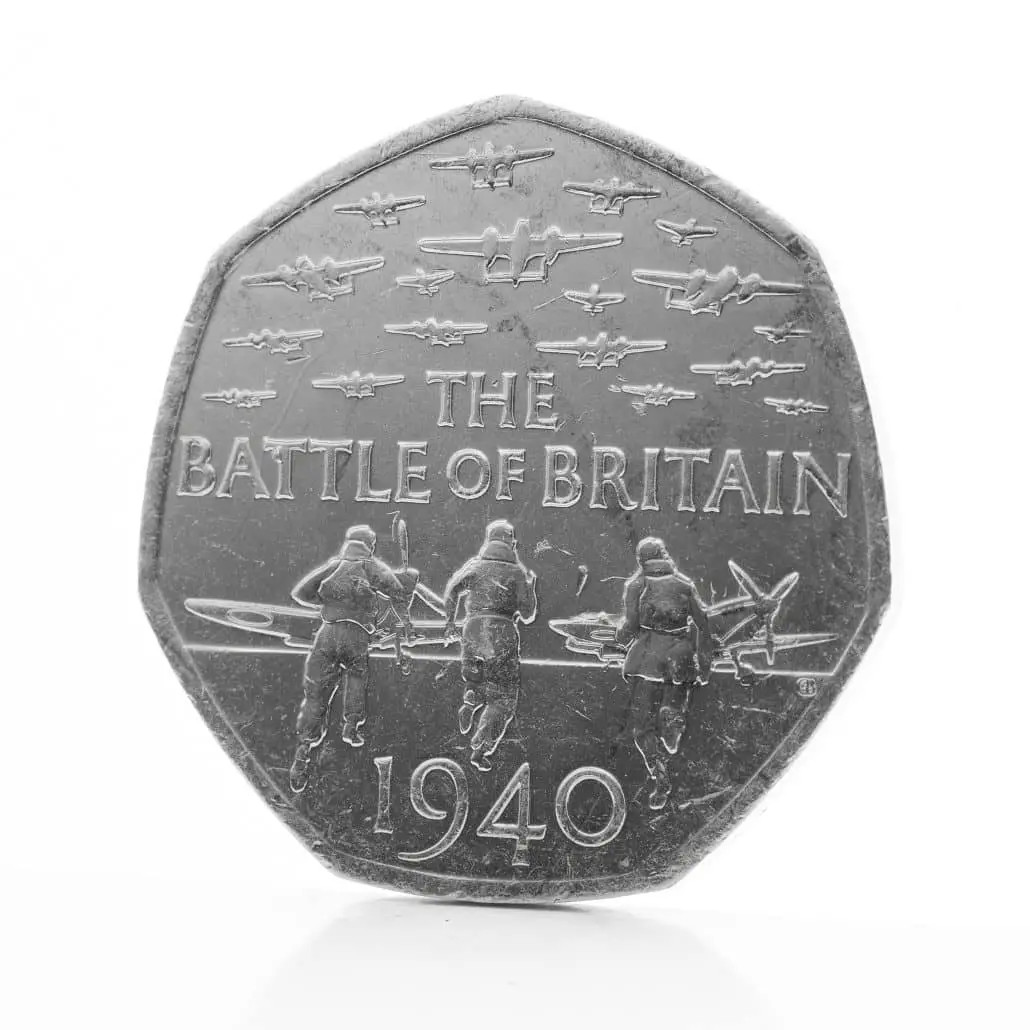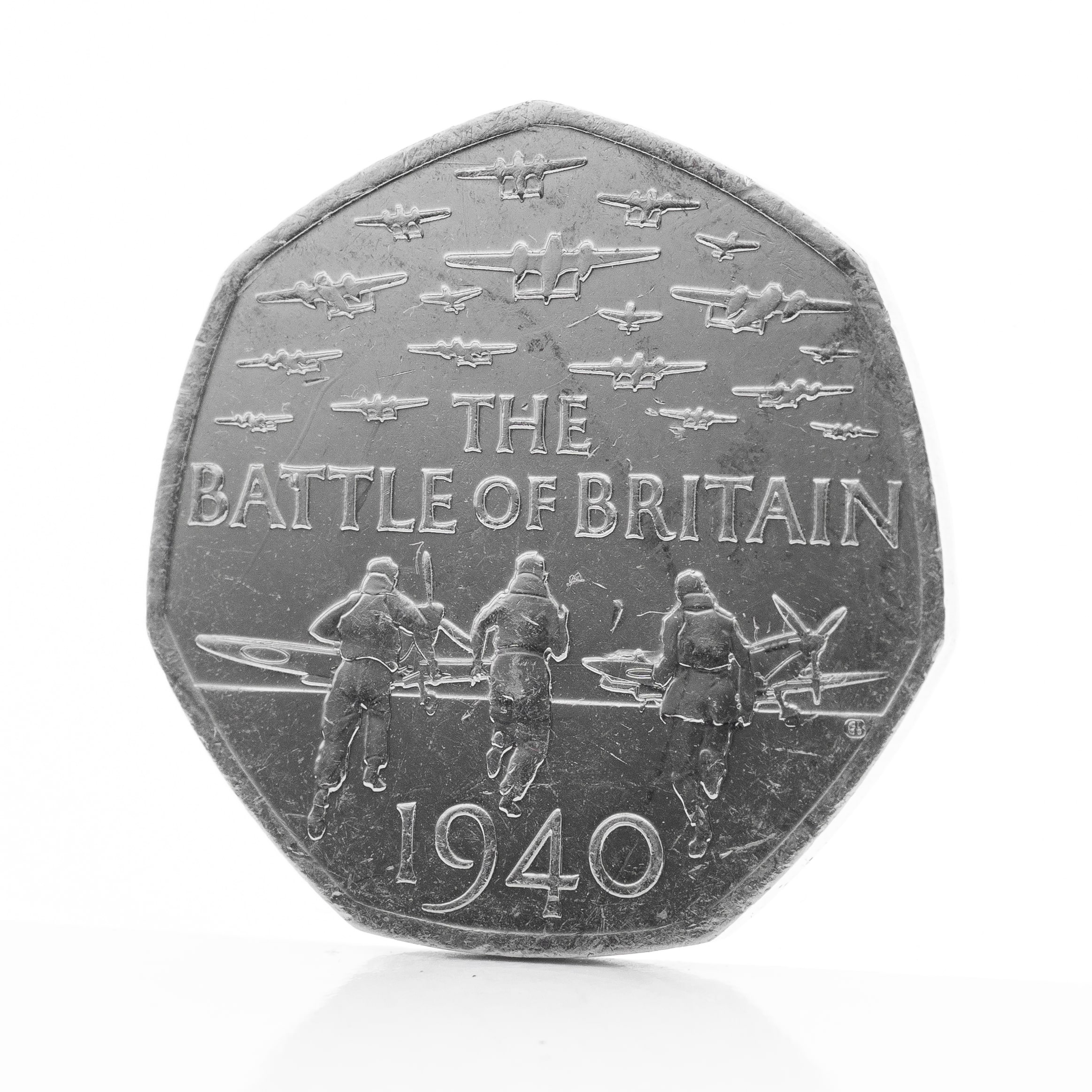The Battle of Britain 50p features an iconic design and has been in circulation for more than 5 years now, but how much is it worth today?
According to average sold values on eBay in 2022, the Battle of Britain 50p is worth £1.46 in circulated condition without postage and packaging.
To understand why the value is almost 3 times face value, let’s dive into the mintage and design of the coin to see if it is actually worth it.
Battle of Britain 50p Mintage
The Battle of Britain 50p has a mintage of 5,900,000 and was released in 2015. The only other 50p coins released this year were the 4th and 5th Royal Shield portrait coins.
The coin is part of the Military History collection that was released by the Royal Mint for collectors which features the 1994 D-Day 50p, the 2005 VC Medal and Award coins, as well as the 2016 Battle of Hastings 50p.
The Royal Mint also produced a gold proof, silver proof and a silver piedfort version with mintage figures of 520, 1,969 and 1,940 respectively.
Is The Battle Of Britain 50 Rare?
A mintage of just under 6 million is not considered to be especially small for a 50p, which means the coin is not particularly rare.
Despite this, it does have an iconic design, and as it has only been in circulation since 2015 there is still a high chance of finding one in your change.
The design of the 2015 Battle of Britain 50p coin
The reverse features a design by sculptor Gary Breeze. Three airmen are seen running away from the viewer, as a squadron of Lancaster bombers soars overhead. The words ‘BATTLE OF BRITAIN’ are inscribed in the middle of the coin and the year ‘1940’ is etched below the airmen.

Breeze has worked on a number of designs for the Royal Mint, but the 2015 Battle of Britain coin is the first of his efforts to make it through to final production. Speaking about designing his coin on his website the sculptor said ‘In some ways, the Battle of Britain appeals to our innate joy at winning against tremendous odds. I did want to celebrate that to a point but something was missing.’
Breeze goes on to describe the design process: ‘I spent some time working on designs based around the aircraft but they didn’t say enough about the meaning of the Battle to us today.’
It was Breeze’s brother, Lee Breeze, an avid coin collector, who suggested that the focus of the design should be on people, rather than planes.
Different Obverse Designs
The Battle of Britain is quite unique in the fact that it has four obverse designs, due to the BU and silver proof versions having unique designs, as well as the version released in the Military History collection.
This happened because the coin was released in 2015, the year when the obverse portrait of Queen Elizabeth changed from Ian Rank Broadley’s design to Jody Clarks. Then, in 2019, the date on the obverse is obviously unique to reflect the year.
- Version 1 – 2015 Ian Rank-Broadley portrait with no denomination given in Brilliant Uncirculated.
- Version 2 – 2015 Jody Clark portrait with no denomination given in Silver Proof.
- Version 3 – 2015 Jody Clark portrait with ‘FIFTY PENCE’ given as a denomination in circulation
- Version 4 – 2019 Military History collectable set with Jody Clark obverse.
Commemoration of the Coin
The Battle of Britain was a major air battle in the Second World War. Fought over the skies of Britain and the English Channel between 10th July and 31st October 1940. The conflict is regarded as the first major battle fought solely with air power in the history of mechanised conflict.
After the fall of France in 1940, Hitler and his generals drew up plans for a full-scale invasion of Britain, codenamed Operation Sea Lion. The Fuhrer knew that given the strength of the Royal Navy and the RAF, any expeditionary force would be decimated unless the Luftwaffe could control the skies over the Channel and southern England.
The combined forces of the Royal Navy’s Fleet Air Arm (FAA) and the Royal Air Force, battled day and night to keep the Luftwaffe at bay and prevent the first invasion of mainland British soil in centuries.
British Spitfire’s and Hurricanes fought head-to-head with Nazi Messerschmitts, Junkers and Focke-Wulfs. Despite being outnumbered by around 40%, Allied forces inflicted heavy losses on the German aircraft. Nearly 2,000 Luftwaffe fighters and bombers were lost, with the Allies losing approximately 1,700. 735 German soldiers and airmen were wounded, with 925 being captured from crashed aircraft in the Channel and mainland Britain.
In mid-September, it became apparent to all sides that the Nazi’s plan to destroy the RAF had failed. As the RAF’s fighter plane output rose above that of its losses, Hitler officially postponed the invasion indefinitely on September 17th 1940 – the date that is officially recognised as the end of the battle.
Remarkably, at the end of the battle, the RAF had more aircraft than it had started with. The heroism of the RAF, and the monumental industrial effort to produce replacement planes, had won the day. Hitler would never again attempt another invasion of Britain, nor pit the Luftwaffe against Fighter Command at its full strength.
Where can you buy the coin?
There are a couple of different places where you can pick up a Battle of Britain 50p.
If you’re looking for an uncirculated version, then you can’t go far wrong with eBay. Make sure you’re not paying too much by going with the guide price at the top of this article and make sure you do your due diligence before you make your purchase.
If you want an uncirculated version then definitely check out the Royal Mint’s 50 years of the 50p Military set for a 2019 edition, or for the proof and brilliant uncirculated versions that were released in 2015.
